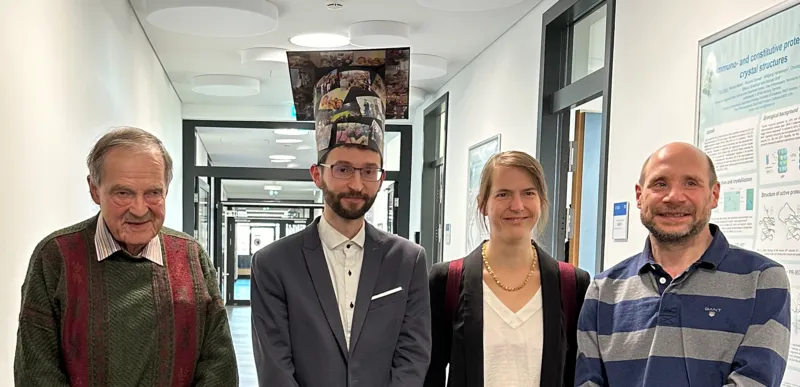Ruben Weiß successfully defended his PhD Thesis-Congratulations!

Raman–Mikrospektroskopie und oberflächenverstärkte Raman–Streuung für die zerstörungsfreie, dreidimensionale Analyse von Mikroorganismen und Biofilmen
Abstract
For environmental studies and clinical diagnostics, the detection and characterization of microbes are essential. If microorganisms occur within biofilms or intracellularly in host organisms, three-dimensional Raman microspectroscopy (3DRM) enables them to be examined. This work used artificial biofilms to show that structures can be resolved at least to a measuring depth of 500 μm on a low single-digit micrometer scale. In an actual environmental sample of a cooling tower infected with Legionella, substructures with characteristic Raman signals of hydroxybutyrate were detected within an object classified as an amoeba. A possible subtyping of L. pneumophila using Raman microspectroscopy and data analysis by principal component analysis is shown. The use of surface-enhanced Raman scattering (SERS) to detect and characterize microorganisms is an emerging analytical technique. Optimized SERS methods enable rapid measurement results with specific molecular information and provide insight into the chemical composition of microbiological samples. For reliable SERS-based analyses, knowledge about the origin of microbial SERS signals and their parameters that affect occurrence, intensity and reproducibility is crucial. This work examines the applicability and limitations of SERS-based method for microbial cell characterization, cell sorting and three-dimensional visualization of microbial communities. Analysis of three gram-negative bacterial species, two gram-positive bacterial species, and an archaeon shows that several of these organisms lack distinct features in their SERS spectra. As an additional confounding factor, the physiological conditions of the cells, such as storage conditions or labeling with deuterium, were systematically examined, from which it can be concluded that the metabolic activity strongly influences the respective SERS signal of individually analyzed cells. This makes the interpretation of SERS data challenging but may prove valuable for insights into the metabolic state of individual cells in microbial populations.